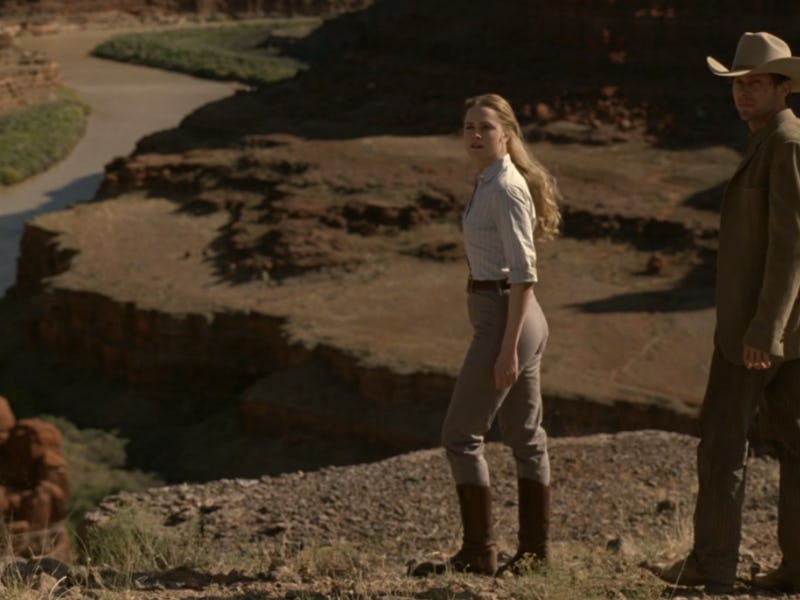Mild Westworld episode seven spoilers ahead.
Host development in Westworld has followed a trajectory that is curiously similar to the arc of human evolution. In “Trompe l’Oeil,” the show’s seventh episode, Dolores sketches a picture from her own imagination, putting her on intellectual par with Homo sapiens that lived between 30,000 and 70,000 years ago, after what evolutionary scientists refer to as the Cognitive Revolution. If human history is to be our guide to the show, it’s fair to predict that we’ll be seeing the development of religion — and maybe even its demise — in the coming episodes.
In the book Sapiens, which traces the human evolution from ape species to hunter-gatherers to robot creators, historian Noah Yuval Harari points out that we weren’t much better off than our evolutionary brothers and sisters — other human species like Homo neanderthalensis, Homo erectus, Homo naledi, and the like — until a quirk of genetics kicked off the growth of our brains, thereby paving the way for us to generate complex language. Advanced words gave way to advanced thoughts, allowing us to generate fictional ideas that were not based in the material world, such as deities, laws, and, as Westworld pointed out in this episode, imaginative art.
A cognitively advanced Dolores reveals herself as the next robot Monet.
Dolores has painted scenes in previous episodes, but she was always “copying the world outside.” In episode seven, she sketches a scene she’s never seen before. “This morning I woke up and I thought, ‘What if I drew something new?’ I imagine something beautiful. A place where the mountains meet the sea,” she tells William the morning after they get it on for the first time.
Imagination is not a luxury pre-language humans were thought to have. Just like our chimpanzee and bonobo cousins, they were not able to come up with fictional ideas because they didn’t have the linguistic ability to express them in their minds. A similar idea was floated in episode 3 of Westworld, when the “bicameral mind” theory is introduced to explain that it’s impossible for an individual to be self-aware unless they’ve got the metaphorical language to form the concepts required for consciousness. Dolores — as recent episodes have shown — is already equipped with those linguistic tools, seeing as she’s already having glimpses of self-awareness. It’s not a stretch to posit that her ability to comprehend and form complex concepts has led to her powers of imagination and capacity to make art. Even when, later in the episode, it’s revealed that the “dream” she had based her sketch on is in fact a real place, it isn’t clear whether she’s actually been there before or whether her imagination was just that powerful.
The parallel cognitive breakthrough had taken place in some Homo sapiens living around 40,000 years ago near a German cave now known as Hohlenstein-Stadel. In 1939, archaeologists digging in the cave uncovered a figurine with the head of a lion but the body of a human (whether it’s male or female remains highly contested) carved out of pure ivory. This work — the Stadel Lion Man (or woman) — is thought to be one of our species’ first piece of figurative sculpture and is described by Harari as an “indisputable” example of “the ability of the human mind to imagine things that do not really exist.”
The Stadel Lion Man is thought to be one of the earliest examples of Homo sapiens imagining things that do not exist. Religions and gods came next.
Nobody really knows what the Stadel Lion Man was meant to represent, but many historians would bet that the figurine was connected to a sort of primitive religion, which also developed out of a newfound ability to form fictive ideas. The bicameral mind theory predicts this too: Once humans had the ability to recognize voices in their heads telling them what to do, they attributed them to gods because they were not yet able to grasp the idea that those commands were actually self-generated.
We’ve already seen traces of the religious pop up in Westworld, like the weird steeple in Ford’s secret project space, the mythology surrounding the maze, and the Indian dolls resembling the lab technician “gods.” At this point in the season, there’s no question that many of the hosts are past their Cognitive Revolution, and it will not be surprising if the show continues to trace human evolution by showing the development of religion among the hosts — and likewise, its eventual demise after a robotic Enlightenment.
